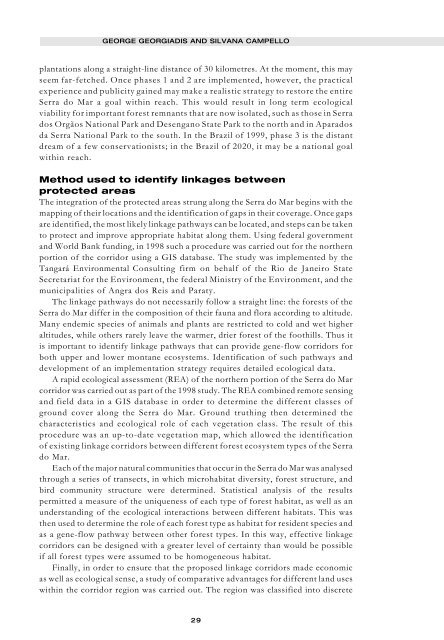Parks - IUCN
Parks - IUCN
Parks - IUCN
You also want an ePaper? Increase the reach of your titles
YUMPU automatically turns print PDFs into web optimized ePapers that Google loves.
GEORGE GEORGIADIS AND SILVANA CAMPELLO<br />
plantations along a straight-line distance of 30 kilometres. At the moment, this may<br />
seem far-fetched. Once phases 1 and 2 are implemented, however, the practical<br />
experience and publicity gained may make a realistic strategy to restore the entire<br />
Serra do Mar a goal within reach. This would result in long term ecological<br />
viability for important forest remnants that are now isolated, such as those in Serra<br />
dos Orgãos National Park and Desengano State Park to the north and in Aparados<br />
da Serra National Park to the south. In the Brazil of 1999, phase 3 is the distant<br />
dream of a few conservationists; in the Brazil of 2020, it may be a national goal<br />
within reach.<br />
Method used to identify linkages between<br />
protected areas<br />
The integration of the protected areas strung along the Serra do Mar begins with the<br />
mapping of their locations and the identification of gaps in their coverage. Once gaps<br />
are identified, the most likely linkage pathways can be located, and steps can be taken<br />
to protect and improve appropriate habitat along them. Using federal government<br />
and World Bank funding, in 1998 such a procedure was carried out for the northern<br />
portion of the corridor using a GIS database. The study was implemented by the<br />
Tangará Environmental Consulting firm on behalf of the Rio de Janeiro State<br />
Secretariat for the Environment, the federal Ministry of the Environment, and the<br />
municipalities of Angra dos Reis and Paraty.<br />
The linkage pathways do not necessarily follow a straight line: the forests of the<br />
Serra do Mar differ in the composition of their fauna and flora according to altitude.<br />
Many endemic species of animals and plants are restricted to cold and wet higher<br />
altitudes, while others rarely leave the warmer, drier forest of the foothills. Thus it<br />
is important to identify linkage pathways that can provide gene-flow corridors for<br />
both upper and lower montane ecosystems. Identification of such pathways and<br />
development of an implementation strategy requires detailed ecological data.<br />
A rapid ecological assessment (REA) of the northern portion of the Serra do Mar<br />
corridor was carried out as part of the 1998 study. The REA combined remote sensing<br />
and field data in a GIS database in order to determine the different classes of<br />
ground cover along the Serra do Mar. Ground truthing then determined the<br />
characteristics and ecological role of each vegetation class. The result of this<br />
procedure was an up-to-date vegetation map, which allowed the identification<br />
of existing linkage corridors between different forest ecosystem types of the Serra<br />
do Mar.<br />
Each of the major natural communities that occur in the Serra do Mar was analysed<br />
through a series of transects, in which microhabitat diversity, forest structure, and<br />
bird community structure were determined. Statistical analysis of the results<br />
permitted a measure of the uniqueness of each type of forest habitat, as well as an<br />
understanding of the ecological interactions between different habitats. This was<br />
then used to determine the role of each forest type as habitat for resident species and<br />
as a gene-flow pathway between other forest types. In this way, effective linkage<br />
corridors can be designed with a greater level of certainty than would be possible<br />
if all forest types were assumed to be homogeneous habitat.<br />
Finally, in order to ensure that the proposed linkage corridors made economic<br />
as well as ecological sense, a study of comparative advantages for different land uses<br />
within the corridor region was carried out. The region was classified into discrete<br />
29

















